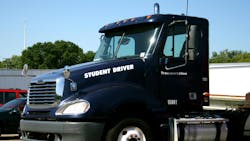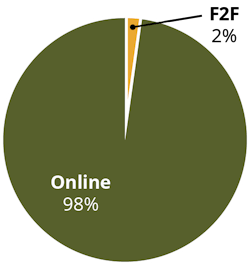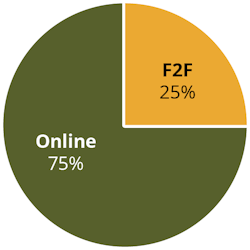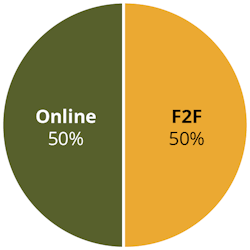Strategies to make driver training stick beyond traditional classroom presentations
Key takeaways
- Traditional orientation methods overload working memory, reducing retention and driver preparedness.
- Blended and flipped learning approaches improve engagement, knowledge recall, and safety outcomes.
- Ongoing access to digital resources reinforces critical skills and supports long-term compliance.
The typical orientation structure runs counter to how most adults learn. Many companies hold three- to four-day orientations that involve a trainer lecturing alongside PowerPoint slides. Research shows that most people forget half of what they hear within one hour, so it’s no surprise learners forget most of the content.
These presentations utilize only one of the five interaction modes for learning. In a learner-to-instructor interaction, such as the orientation example, the learner engages with the instructor, and most of the content presented enters the driver’s working memory through their primary senses. However, the information will leave their working memory soon after that class unless it is encoded through emotional resonance, novelty, or personal relevance.
So, why do we continue to present information this way?
Every brain has a cognitive capacity. Everyone processes differently, and like holding one’s breath, some can hold on longer than others. Even without learning impairments, many learners’ brains are drowning in working memory overload. But with a few tweaks in a presentation, we can make content stick, improving safety and changing behavior.
Here are a few examples of orientation frameworks that can be combined to create the most impactful orientation experiences.
Example 1: Online laboratory
Place learners at the center. Use in-person time to connect them to the organization’s ‘why’ and the learning community, as in-person experiences foster a sense of belonging and purpose. The ‘what’ and ‘how’ can be learned online.
- Put lecture-style content online so it’s searchable and accessible when learners need it. For example, instead of delivering training on Day 4 of orientation, shift the content to a just-in-time online session with the payroll administrator the afternoon before checks are issued. This reduces questions and ensures learners get what they need at the right time.
- Build safety nudges and connections by hosting live online Q&A sessions, then record them so they can be referenced later.
- Create thought-provoking questions and discussions that learners can engage with anytime, anyplace.
Example 2: Flipped classroom
Begin with a substantive face-to-face or online session, followed by shorter sessions. This approach, called an anchor blend, might involve 75% online learning and 25% face-to-face learning, or the reverse, depending on the learners' needs.
- Have learners complete forms online before they attend class in person.
- Use learning preference or cognitive assessments to shape classroom structure.
- Dedicate classroom time to road tests, hands-on demonstrations, and reinforcing critical topics while emphasizing relationship building.
- Afterward, use short microlessons to reinforce key points.
Example 3: Group rotation
Organize learners into groups or pods—complete with team names, T-shirts, badges, or mascots—to build camaraderie and a sense of community. This connection can begin in person and continue online through virtual learning communities.
- Rotate pods between activities such as hands-on ELD learning, truck demonstrations, or meeting the safety director.
- Capture content online so learners can review it later and reinforce recall through repetition.
- Move groups together through the activities, both online and in person.
Example 4: Supplemental and reference repository
A field-blend approach treats learning as an ongoing experience. Key concepts are introduced on day one and reinforced throughout a learner’s career.
- Present big ideas in person, and reinforce them online as part of a regular cadence.
- Make handbooks, forms, permits, and instructions accessible on tablets or phones via QR codes.
- Use online conferencing to connect with learners ahead of face-to-face sessions.
- Capture safety meetings for compliance and connection.
- Share video messages to build emotional resonance around big ideas over time.
- Use discussion forums to engage learners on important topics like weather, financial wellness, or mental health.
There are countless ways to make learning stick beyond basic PowerPoint slides. Keep learners engaged, not overwhelmed—in this field, the stakes are higher than grades. Here, safety and lives depend on it.
About the Author

Gina Anderson
Dr. Gina Anderson is the CEO of Luma Brighter Learning, a learning company. Anderson is a learning scientist who publishes new, measurable, science-based techniques focused on learning in the supply chain ecosystem to help companies improve safety, uphold compliance, and reduce risk. Anderson is a TedX speaker and is the author of Thrive: How Learning Can Ignite a New Way Forward.






